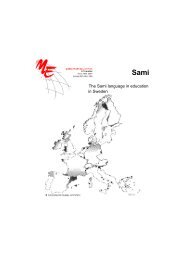Multilingual Early Language Transmission (MELT) - Mercator ...
Multilingual Early Language Transmission (MELT) - Mercator ...
Multilingual Early Language Transmission (MELT) - Mercator ...
Create successful ePaper yourself
Turn your PDF publications into a flip-book with our unique Google optimized e-Paper software.
child could be offered a tailor-made curriculum, differentiated for mother tongue and<br />
second language acquisition. The true role of language policy is the development and<br />
realisation of that ideal in practice as much as possible within a given linguistic situation.<br />
6.4 Recommendations with respect to <strong>Early</strong> <strong>Language</strong> Learning and<br />
<strong>Multilingual</strong>ism<br />
The European Commission has identified pre-primary education as a priority theme for<br />
cooperation between Member States in 2009-10, in particular to promote generalised<br />
equitable access and reinforce the quality of provisions and teacher support . Recently, in<br />
July 2011, the European Commission released a Staff Working Paper within the Strategic<br />
Framework for Education and Training (ET 2020): <strong>Language</strong> Learning at Pre-primary school<br />
level: Making it efficient and sustainable. A policy handbook (SEC (2011)928. In this working<br />
paper on <strong>Early</strong> <strong>Language</strong> Learning (ELL) all general aims, goals and benefits of early<br />
multilingualism are summarised and proclaimed: “The aims of any ELL policy for children in<br />
pre-primary education should be to foster intercultural and multilingual education focused<br />
on the development of the child’s personal potential. Where appropriate, it could also be to<br />
provide an introduction to a particular language that will be taught later on in primary<br />
school” (p. 9). Within this working paper a special chapter is dedicated to ‘Children with a<br />
minority or migrant background’. In that chapter a double message is emitted. On the one<br />
hand the benefits of multilingualism are underscored: “Children with a minority or migrant<br />
background will usually benefit when offered equal opportunities to access language<br />
learning and support to maintain and improve both their first language/mother tongue and<br />
the second language. Their established repertoire should therefore be further valued and<br />
promoted” (p. 23). On the other hand, the transitional approach is promoted: “The<br />
participation of these children in programmes that provide systematic language support in<br />
the language of instruction at pre-primary level should therefore be encouraged, since it<br />
would be beneficial for their social integration and educational journey” (p. 22). The<br />
phrasing suggests an opposition between the maintenance and fostering of mother tongue<br />
which differ from the state language, and the language of instruction at school. From the<br />
perspective of equal footing of mother tongue and standard language, both languages of<br />
education serve to foster the child’s social integration and educational journey. Explicit<br />
language policy and measures are essential in order to put formal declaration into practice.<br />
The EU policy handbook at hand which is aimed at national authorities and administrations<br />
in charge of childhood education and care and of language education, further stresses the<br />
importance of lifelong learning, and the increase of awareness of linguistic diversity, the<br />
importance of informal settings for language acquisition by language use in the right cultural<br />
context. Also the training of staff is recommended as well as permanent and consistent<br />
advice to parents and families who often find it difficult to choose which language(s) they<br />
should use to raise their children.<br />
This research paper and indeed the Guide for practitioners as well as the parents’ pamphlet<br />
of the <strong>MELT</strong> project are without doubt of great value for the deepening of insight – both<br />
theoretical and in practice – of multilingual children’s language development in the preschool<br />
age.<br />
82



